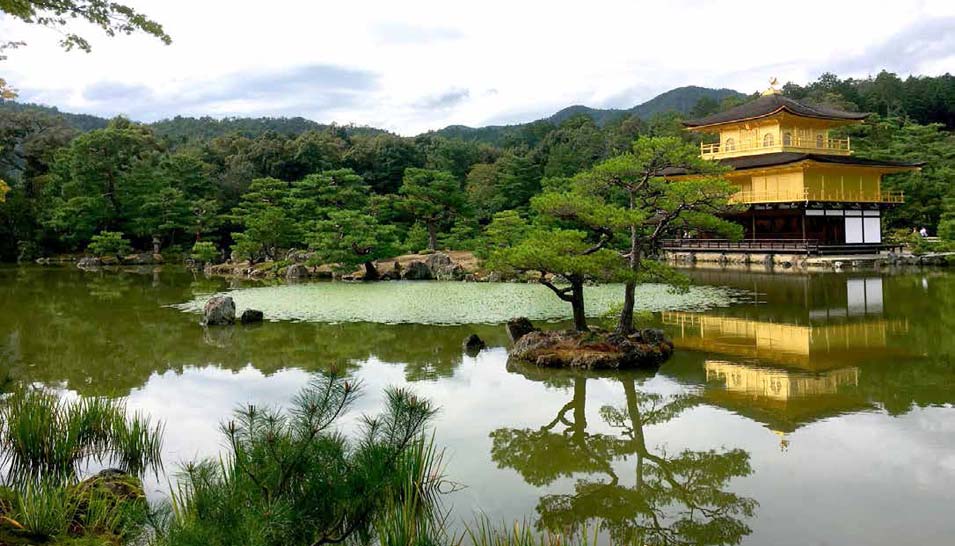
Kinkakuji, Kyoto
When you walk along the roads in Japan, you experience not only the charm of a beautiful country, but you find yourself immersed in a lush, neat, organized greenery, in full harmony with the places of worship and deep spirituality.
Japan is a country of huge contrasts where the modernity of the metro with its towering skyscrapers, colorful neon signs, and massive crowds filling the streets are somehow always composed, with people exhibiting great hospitality while being discreet and noninvasive, with respect and helpfulness always on display.
The Beauty of Nikko

The Japan countryside is where nature
meets man in the most serene and
beautiful interface, with walking paths,
majestic pagodas, and marvelous
waterways among the images that dot
the landscape.
Not far from Tokyo rests the beauty of Nikko. Climbing along nature trails, one arrives at the Tosho-gu Mausoleum, built in 1634. More than 15,000 artisans worked there, lacquering, painting, carving, and decorating for two years to create this wonderful complex.
Inside you can admire a five-story pagoda built in 650.
The Omoto-mon is the main entrance after the pagoda, and it is guarded by two statues of Deva kings. Here, there are three sacred stores in which wood was kept and a sacred spring exists for washing hands. The Shinkyusha, a sacred stable, is also here and houses the famous sculpture of three monkeys that “see no evil, hear no evil, speak no evil.”
Nikko’s beauty is remarkable, its artistic richness amazing. One thing that strikes you about this sanctuary is that it is a spot of color in the green. Red, which has cultural significance, is predominant. For the Japanese, the brilliance of red represents the sun and happiness. It can even be found on the nation’s flag.
Kegon Falls
When my husband and I visited, it was the pervasiveness of the natural landscape that persuaded us to extend our exploration upward toward Kegon Falls. We got on a bus that tackled the hard uphill hairpin bends, and we went up in the mountains to visit the small villages. After reaching our destination, we took a lift to access a vantage point from which you can see the falls in all of their majesty.
The sunset came quickly, the rather overshadowed sky let in a faint light which created an extraordinary scene that was rich with iridescent reflections on the waters of the little lake.
Discovering Kyoto, Kinkakuji
In Kyoto, we headed to the Arashiyama district to see the bamboo forest. Here, the bamboo is more than 10 meters high and completely engulfs you on your journey. The sound of rustling wind, combined with the singing of birds, made this place uniquely meditative and one of the most beautiful forests on the planet.
Still discovering Kyoto, we went to Kinkakuji, which is the name of the Golden Temple. This wonderful pagoda contains the Buddha’s relics and is covered with golden leaves.
Gold has a strong symbolic value of purification from all kinds of pollution or negative thinking. The warm color of the walls and surrounding nature welcomes and embraces visitors. My husband and I stopped there and devoted some time to enjoy the place!
Charming Shrine
Another place that we found very charming was the shrine dedicated to the Kami Inari, located in Fushimi-ku, west of the Kyoto area. Located at the base of a mountain, the sanctuary includes several trails to other smaller shrines. The first structures were built in 711 on Inariyama hill in the southwest of Kyoto, but the sanctuary was moved in 816 at the request of Kukai Monaco. The main structure of the shrine was built in 1499.
At the bottom of the hill lies the main gates to the sanctuary. Behind them in the middle of the mountain, the inner sanctuary is reached by a stairway lined with thousands of torii. They are the heart of this shrine, and the liveliness of their red captures your eye and draws you into the infinite illusion. The torii become progressively more linear and stylized in succession, skirting the stairs immersed in lush vegetation and creating this vision to the infinity.
On top of the mountain there are hundreds of altars. Many of the altars have votive objects, lamps, statues, and messages. Each torii at Fushimi Inari-taisha was donated by a Japanese company. Foxes (kitsune), considered messengers, are often found in Inari shrines depicted with keys to the rice store in their mouth.
The Castle of Himeji
Another amazing corner of Japan is Himeji, a castle built for military purposes, erected in 1601. It is one of the oldest structures of the Sengoku period. The Himeji Castle is also known by the name of Hakurojō, or Shirasagij, which means white heron, because of its appearance of a bright white color. The tall stone foundations, the white walls, the bastions, the access doors, the maze of narrow streets leading to the central tower, the organization and layout of the buildings within the complex, and the artillery positions and holes in the walls used to throw stones at the enemy are only intended to be a deterrent for any attackers and allow the defenders to have them constantly in check.
You can dream a fairytale and you can then relive it in Himeji Castle. You can imagine princesses wearing precious kimonos who pace through the private rooms of inner courtyards, and you can imagine a white building that is colored by flowers thanks to the surrounding park.
Japan is a reminder of nature, spirituality, modernity, efficiency, and a civilization that makes life livable — a place that satisfies both body and soul.